Snow squalls hovered over heaving whitecaps in the slate-gray Sea of Japan as six Vought F4U-4 Corsairs went “feet dry” north of Hungnam on Dec. 4, 1950.
Pine-covered North Korean mountains, draped with deep snowdrifts and obscured by clouds, came into view. The clouds soon broke, revealing the flat, windswept expanse of the desolate Chosin Reservoir.
U.S. Navy fighter squadron VF-32’s Iroquois Flight leader, Lt. Cmdr. Dick Cevoli, turned north as the Corsairs passed the ruined village of Yudam-ni, site of a deadly battle between the 1st Marine Division’s 5th and 7th regiments and the Chinese People’s Volunteer Army.
The 96-hour battle had only ended that morning when the surviving Marines successfully came through the 11 miles of Toktong Pass to the relative safety of Hagaru-ri, at a cost of 100 men per mile.
Cevoli glanced over at wingman Lt. George Hudson. Beyond him was the second element, Lt. j.g. Bill Koenig and Ensign Ralph McQueen. The third element, leader Ensign Jesse Brown and wingman Lt. j.g. Tom Hudner, was slightly behind.
As they flew over a mountain valley on the far side of the reservoir, Koenig saw what looked like fuel leaking from below Brown’s fighter, and radioed, “Jess, check your fuel status.”
As he soared over the ridge below, Brown felt his Corsair’s engine stutter and called: “This is Iroquois One-Three. I’m losing power. I have to put it down. Mayday. Mayday.”
Brown released his under-wing ordnance.
As the F4U’s nose dropped, Hudner warned, “Watch your airspeed.”
The others watched, helpless, as Brown descended toward a bowl-shaped clearing on a mountainside.
Hudner winced as he saw the Corsair touch down in a cloud of snow and plow across the field, throwing a rooster tail of snow behind until it came to an abrupt stop, nearly into a line of bordering trees.
Hudner watched for signs of movement from Brown as he circled lower and spotted smoke wafting from the broken cowling.
“Get out, Jesse!” he radioed. “Come on!”
Still there was no movement.
“Somebody was going to have to go down and help,” Hudner recalled. “Since nobody else was volunteering, I decided it would have to be me.” He ditched his ordnance and called, “I’m going in.”
As he saw the ground come up fast, he thought, “This is really stupid, you know?”
“The ground seemed to rush at me as I hit,” he continued, “and then I was out of control, snowplowing across the field and hoping I was going to end up somewhere close to Jesse.”
His Corsair slammed around 90 degrees and slewed to a stop. As the snow settled, Hudner could see he was about 80 yards from Brown.
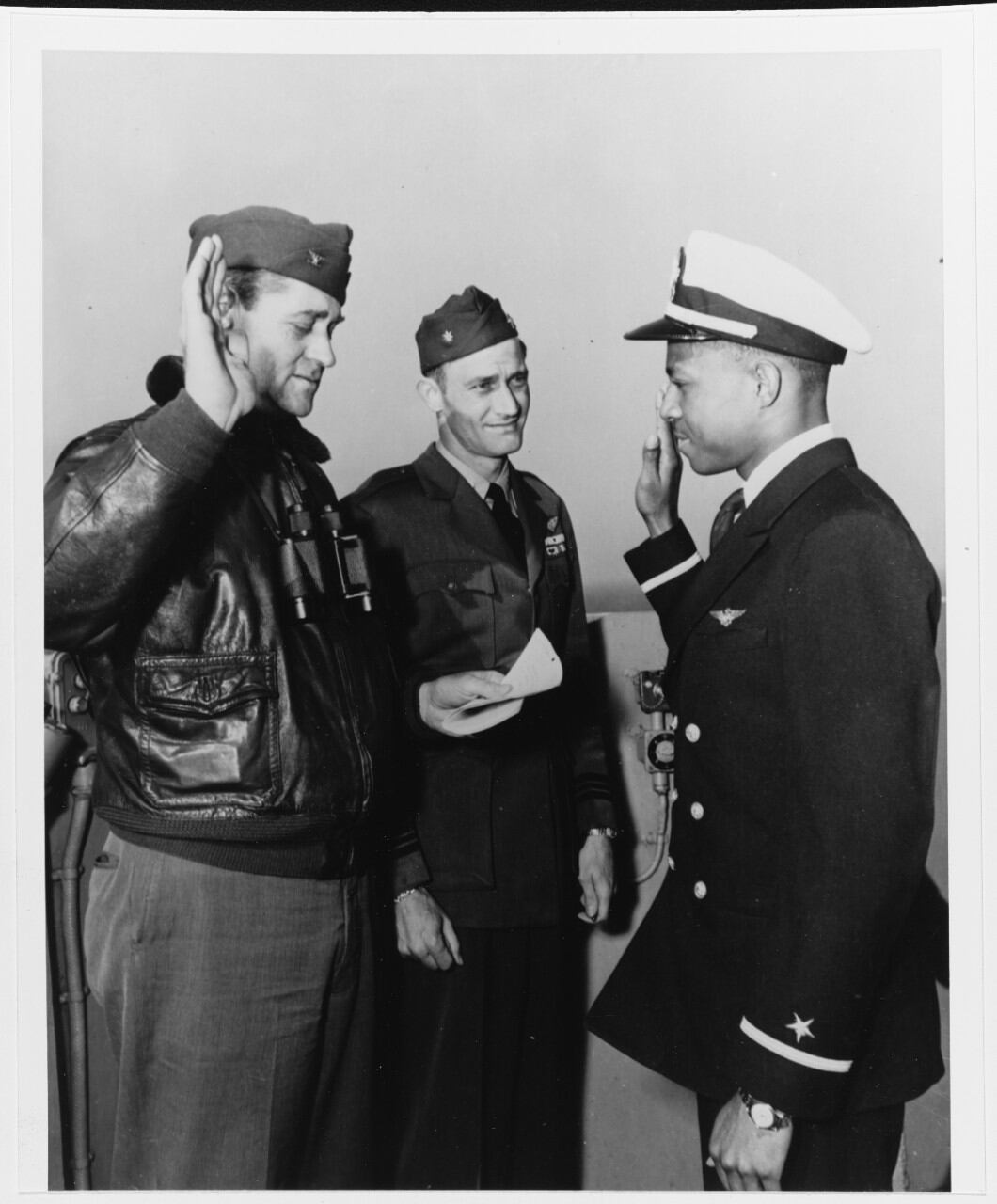
Tom Hudner and Jesse Brown couldn’t have been more unlike. Hudner was a U.S. Naval Academy graduate, the oldest of five children of a successful Irish businessman who owned Hudner’s Markets in Boston.
After serving as a communications officer on board several ships, he became a naval aviator in 1949.
Jesse L. Brown Jr. was a sharecropper’s son from Hattiesburg, Mississippi. He entered the aviation midshipman program after graduating through an NROTC scholarship from Ohio State, and in 1948 became the first African-American naval aviator.
The two met on board the aircraft carrier Leyte in early 1950. At the time VF-32, “The Swordsmen,” flew Grumman F8F-1 Bearcats.
Brown was recognized as the squadron’s best pilot when he took a wave-off at the last moment, added throttle too rapidly and survived a torque roll less than 100 feet above the deck, recovering in full view of everyone and executing a textbook landing, cool as could be.
Leyte was in Naples when war broke out in Korea in June 1950. The carrier returned to the United States, where VF-32 re-equipped with F4U-4 Corsairs.
Leyte redeployed to the Mediterranean, transited the Suez Canal and crossed the Indian Ocean to arrive in Sasebo, Japan, on Oct. 8.
It put to sea the next day, joining the carriers Boxer, Philippine Sea and Valley Forge of Task Force 77 in the Sea of Japan.

They provided air support for the Marines in their push into North Korea after U.N. commander General Douglas MacArthur made the fateful decision to “roll back” the Communists, heedless of Chinese Premier Chou En-lai’s threat of military intervention if U.N. forces approached the Yalu River.
Belief that the war was won was so strong throughout the U.S. 8th Army during late October that units on the front began pulling combat equipment off the line to prepare it for return to Japan. Officers discarded field uniforms in favor of dress uniforms they would wear in the coming Tokyo victory parade.
Word circulated in the 1st Cavalry Division that the men would wear their yellow cavalry scarves and had better look parade-ground sharp, not battlefield-grizzled.
As Task Force 77’s pilots found fewer targets, sortie rates dropped. Philippine Sea and Boxer departed for Yokosuka on Oct. 22, with Boxer ordered to continue on to the United States. On Oct. 30, Valley Forge retired to Sasebo, with Leyte expected to follow in November.
At first the loss of Navy carrier support did not seem important to the Marines, since they had their own squadrons nearby: VMF-214 and VMF-323 operated F4U-4 Corsairs from Sicily and Badoeng Strait, while VMF-212 and VMF-312 flew land-based F4U-4s alongside VMF(N)-513’s F4U-5N night fighters and VMF(AW)-542’s Grumman F7F-3N Tigercat all-weather night fighters.
At the end of October, however, intelligence revealed signs of increased enemy activity.
U.S. Air Force reconnaissance flights spotted large concentrations of aircraft at Antung airfield on the Manchurian side of the lower Yalu. Air Force and Navy pilots came under fire from anti-aircraft batteries in Manchuria.
On Oct. 31, Lockheed F-80 pilots of the 51st Fighter Interceptor Wing (FIW) reported seeing “silver, arrow-shaped jets” over Antung, tentatively identified as MiG-15s.
First Lieutenant W.P. Garton from VMF(AW)-542 saw the Chinese buildup on his first night mission to the Yalu.
“For one hour, I orbited the Korean side of the river and counted the trucks coming across the bridge between Antung and Sinuiju,” he reported. “The trucks left brightly lit Antung with their lights on; halfway across the bridge, they would switch to black-out lights and grope their way through dimly lit Sinuiju. The traffic appeared to be almost entirely one-way, and I counted over 150 trucks crossing the bridge.”
A week later, Garton saw more than 200 trucks cross in an hour. Still, U.N. headquarters maintained any Chinese intervention would be limited in scope and operations.
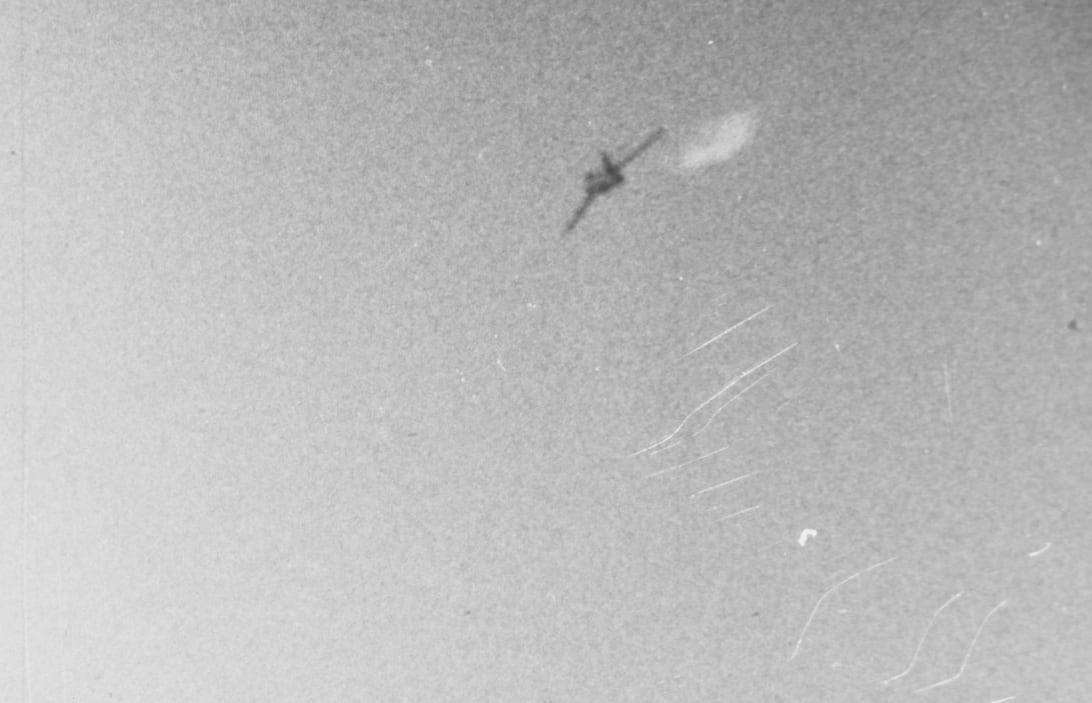
On Nov. 1, the first jet-versus-jet combat in history unfolded when three MiG-15s from the Soviet 72nd Guards Fighter Aviation Regiment — a unit composed of World War II aces — attacked F-80s of the 51st FIW.
The Soviets scored first blood when Senior Lt. Semyon Fyodorovich Khominich claimed an F-80C. Earlier, Senior Lt. Fyodor Chizh downed 1st Lt. Aaron Abercrombie’s F-51D Mustang of the 35th Fighter-Bomber Wing.
The U.S. Air Force officially credited Abercrombie’s loss, as well as the death of F-80C pilot 1st Lt. Frank Van Sickle Jr., to anti-aircraft fire until after the Cold War, when Russian records were released.
That night, Chinese infantry struck the 8th Cavalry Regiment of the 1st Cavalry Division, inflicting heavy losses on the Americans and forcing them to retreat from their positions at Unsan on the Chongchon River, north of Pyongyang.
It was the worst American defeat of the war thus far.
Four days later, Chinese soldiers attacked the 7th Marines at Sudong on the road to Chosin Reservoir, where the Americans hung on by their fingernails in hand-to-hand fighting. Then, as mysteriously as they had appeared, the Chinese vanished back into the forbidding mountains and forests.
Despite warnings from Marines and soldiers that they were encountering the Chinese army, MacArthur downplayed the threat at a Tokyo press conference, claiming that Chinese leaders knew their troops had never been able to stand against Western armies.
“The boys will be home by Christmas,” he promised.
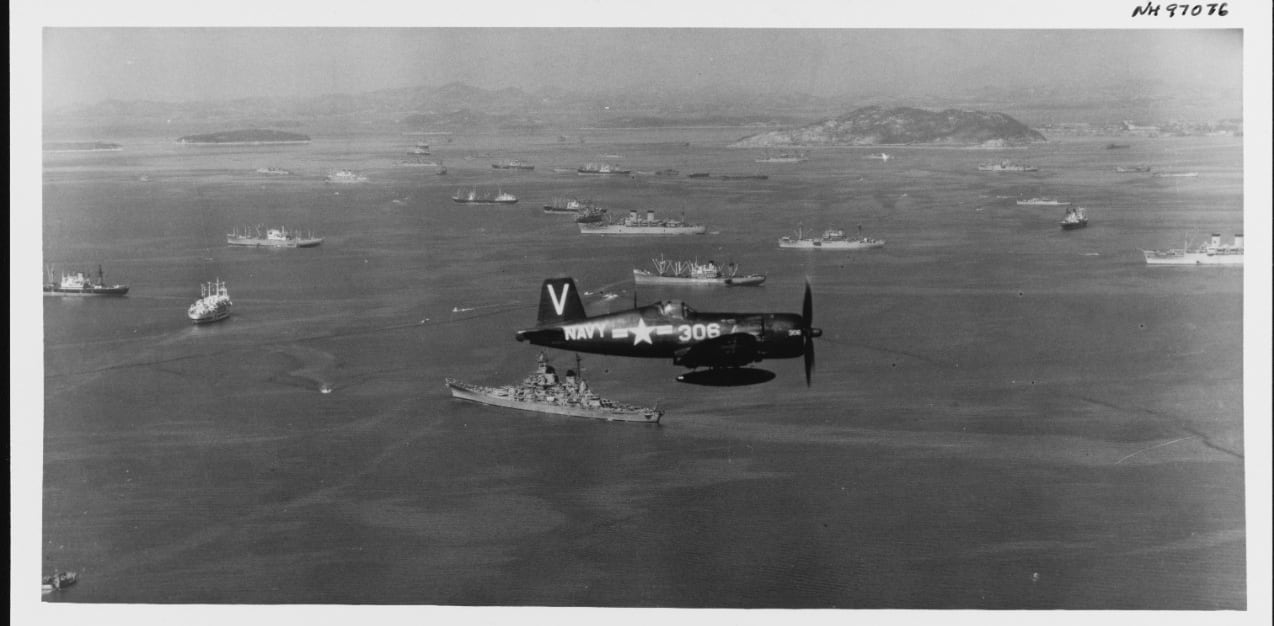
American military officials in Tokyo and Washington would have been amazed to read the report made at the same time by Col. Xie Fang, chief of staff to People’s Volunteer Army commander Marshal Peng Dehuai.
“Our 9th Army Group main forces have successively entered Korea from J’ian and Linjiang to assume eastern front operations," he wrote. "We have over 150,000 men on the eastern front, the enemy over 90,000, giving us a 1.66 advantage over him.
"We have 250,000 men on the western front, the enemy 130,000, giving us a 1.75 advantage over him. Our forces are superior on the eastern and western fronts.”
Meanwhile, the air war heated up, as Task Force 77 struck the Yalu River crossings.
On Nov. 9, Lt. Cmdr. William T. Amen, piloting a Grumman F9F Panther of VF-111, tangled with a MiG-15 flown by Capt. Mikhail Grachev.
“We could clearly see the big runway at Antung across the river in Manchuria but were too far away to ascertain what type of aircraft were parked there,” Amen reported.
“As the ADs [Douglas Skyraiders] started their dives on the bridge, I asked the leader if any of them had sighted MiGs. Ten seconds later a voice told me there was a fast-moving jet coming up behind our formation. I looked and there it was, a shiny swept-wing aircraft banking toward me from my 7 o’clock position. I immediately turned to meet him head-on. The pilot raised his nose and started a steep, almost vertical climb to about 15,000 feet, where he leveled off. Just as he started his climb, my wingman and I got off a burst of 20mm.
"It was ineffective. We stayed on his tail. If we’d hesitated he would have gained the advantage. He already had a 100-knot speed advantage. If he’d chosen to remain straight and level he could easily have outdistanced us, but every time he turned we closed the gap. We were firing short bursts as we closed in, and the other two in our division were firing long bursts as they tried to close in. Evidently that scared him into diving and I followed. My airspeed hit 500 knots and I was firing all the way.
"Suddenly my Panther started to buffet as the nose was trying to tuck under and I hit my dive brakes and stopped firing. The MiG’s dive angle had increased to about 40 degrees. As we passed through 3,000 feet the MiG flipped over on its back. I thought he was either crazy or had one of the best fighters ever built! A second later I could see mountains coming up fast. Then I saw trees and rocks. Pulling hard, I bottomed out with no more than 200 feet to spare. As I turned the nose up, my wingman reported I had gotten the MiG, which had gone straight in and exploded.”
The next day Amen’s Panthers engaged four MiGs in a 10-minute fight during which he damaged one.
After Nov. 11, MiGs intercepted nearly every Navy mission.
On the 18th, Panthers from VF-52 and VF-31 engaged eight MiGs. Lt. Cmdr. William Lamb and Lt. Robert Parker of VF-52 shared one kill while VF-31’s Ensign Frederick Weber scored a second. Despite these victories, it was obvious the MiG-15 was technologically superior to its straight-wing counterparts.
Leyte refueled on Nov. 13, and Air Group 3 flew 130 strike flights over the next two days. They expended so much ordnance that the carrier had to pull off the line on the 16th to refuel and re-arm.
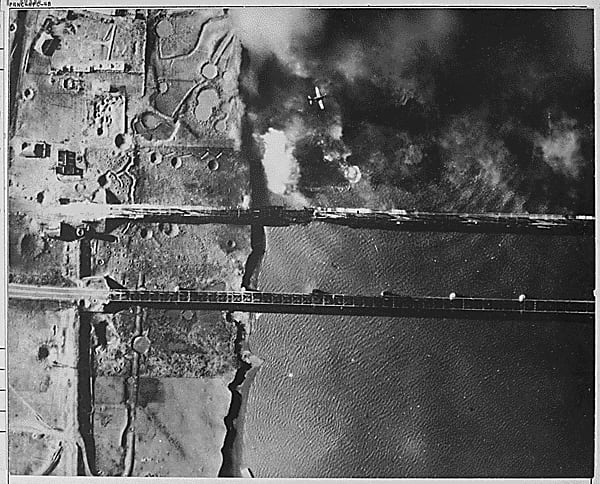
Ed Jennings, at the time a lieutenant junior grade flying AD Skyraiders in VA-195, recalled: “An Essex-class carrier couldn’t carry enough ordnance to support the Skyraider. We could empty the ship in three days of sustained operations.”
After Leyte returned, its pilots flew 145 missions on Nov. 17-18. That pace was about average for the three carrier air groups operating in Task Force 77 at the time, and was maintained throughout the Chosin campaign, despite the miserable weather.
“At that time, we were operating in heavy seas in winter conditions,” Skyraider pilot Cmdr. Harlan Foote remembered. “There were gale-force winds often, and it frequently happened that the ship would take green seas over the bow, which would freeze on the flight deck. Takeoffs were adventurous to say the least, and landing could be a nightmare with the deck pitching through 20-30 feet at times, and rolling constantly.”
Pilots weren’t the only ones who suffered. Sgt. Paul Richter, an ordnanceman with VMF-214 on board Sicily, noted that “Escort carriers toss around like a cork in a heavy sea, and the sea was heavy the entire time.
"Arming a Corsair in the hangar deck was an adventure, just trying not to fall off the ladder as you loaded rockets. I was scared to death to go up on the flight deck for fear I’d be washed overboard.”
In the early morning hours of Nov. 25, the worst Siberian blizzard in a century swept over the Korean peninsula, dropping temperatures below 30 degrees and covering everything with heavy snow.
The storm finally ended at dusk on Nov. 27.
At 2200 hours, bugles blared from the frozen darkness surrounding the Chosin Reservoir as 120,000 hardened veterans of the Chinese 9th Volunteer Army, under the command of Long March veteran General Song Shi-lun, struck from Yudam-ni on the western shore of the reservoir, south to Koto-ri, near the top of Funchilin Pass.
Their orders: “Wipe out the Marines to the last man.”
On board Leyte, dawn broke on Nov. 28 to find the flight deck and aircraft covered with snow. Conditions were the same on Princeton and Valley Forge. For the next seven days, Air Group 3 flew in atrocious sea conditions with blowing snowstorms as its pilots provided close air support to the Marines.
While air power gave the outnumbered Marines a decisive edge, winter flying was dangerous and at times the weather was more hazardous than the enemy. Snowstorms developed quickly and could prevent successful attacks, or created problems when pilots returned to find whiteout conditions over the ship. (Weather forecasts were unreliable because the storms originated in Manchuria and Siberia.)
Take-off could be difficult ashore or afloat, since ice and snow had to be removed each morning from aircraft and flight decks or cleared from runways.
Carrier pilots wore immersion suits in case they were forced to bail out or ditch at sea; even so, they could not survive more than 15 minutes in the freezing water. A man who went down over land could be in even greater danger, since his flying gear provided insufficient protection against the elements.
Although the U.N. air forces had developed an efficient air rescue system utilizing helicopters, the enemy often got to the downed pilot first.
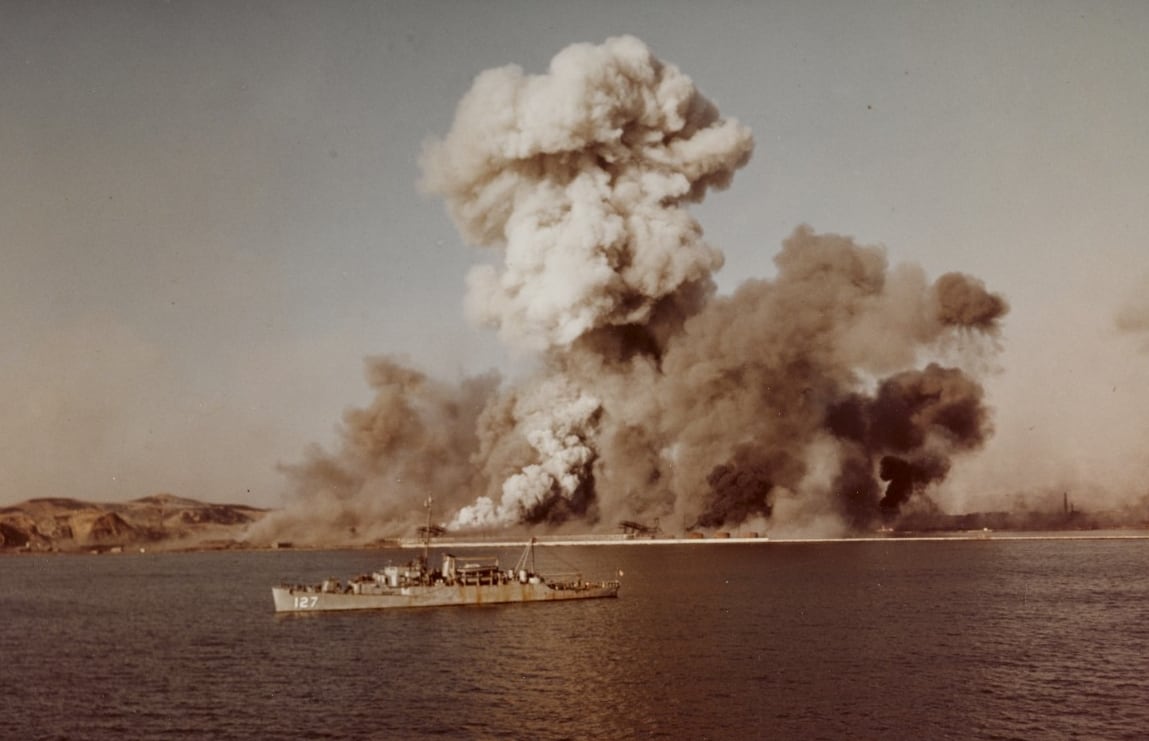
And then there was the recon mission of Dec. 4.
Badly shaken, Hudner climbed out of his Corsair. “The snow was waist deep, it was colder than I have ever experienced anywhere else, and at first I couldn’t move,” he recalled. “It took me over 30 minutes to cover the distance to Jesse’s airplane, and I was damn near frozen stiff by the time I got there.”
Hudner discovered that Brown’s legs had been crushed when the fuselage buckled, pinning him inside the cockpit. Despite Hudner’s best efforts, he found it impossible to pull him free. He piled snow on the smoking Corsair in an attempt to douse the flames while Brown drifted in and out of consciousness.
The sun was going down, and it was even colder in the shadows. Hudner yanked at the instrument panel in a futile attempt to pry it loose. Finally, a helicopter from Marine observation squadron VMO-6 arrived, piloted by 1st Lt. Charles Ward, who joined Hudner in trying to break the plane open with a fire ax.
In the last light of day, when he had to go or risk dying of frostbite himself, Hudner realized his friend had frozen to death. The helicopter lifted off in a cloud of snow, leaving Jesse Brown and his Corsair in the frozen stillness.
In March 1952, Lt. j.g. Thomas J. Hudner Jr. became the only U.S. naval aviator during the Korean War to be awarded the Medal of Honor, for risking his life above and beyond the call of duty by deliberately crash-landing to try to save Brown.
Hudner was one of 17 Americans who earned the Medal of Honor during the Chosin campaign, more than in any other battle of the Korean War.
RELATED
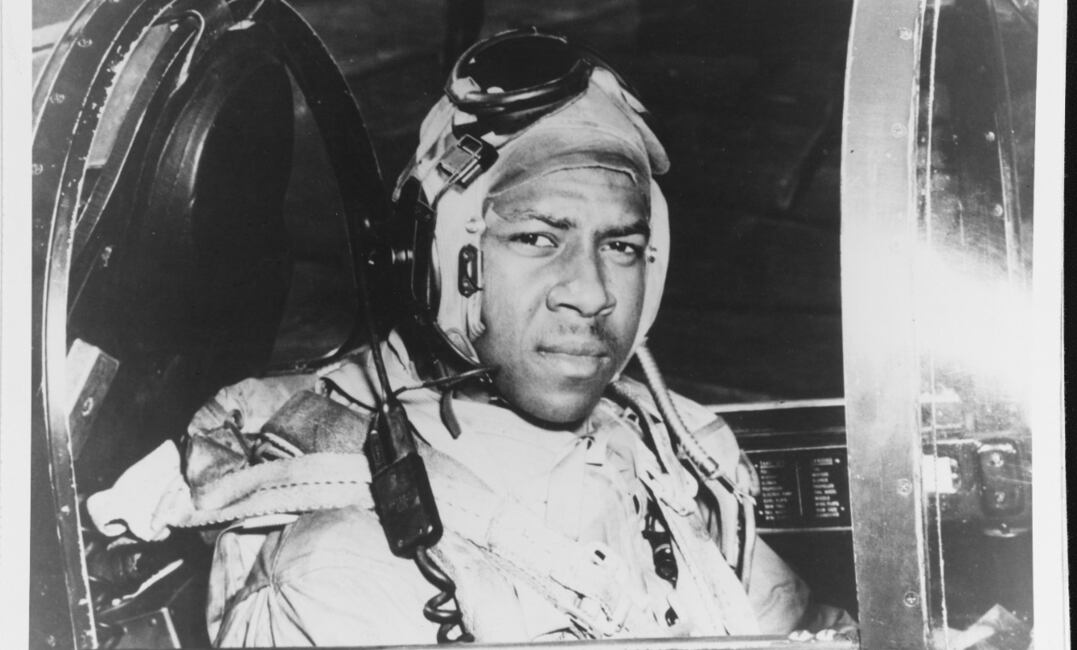
Thomas McKelvey Cleaver is the author of The Frozen Chosen: The 1st Marine Division and the Battle of the Chosin Reservoir, from which this article was adapted. For more on the Hudner-Brown mission, see Devotion: An Epic Story of Heroism, Friendship, and Sacrifice, by Adam Makos. This story was originally published in the March 2017 issue of Aviation History magazine, a sister publication of Navy Times. Subscribe here.




